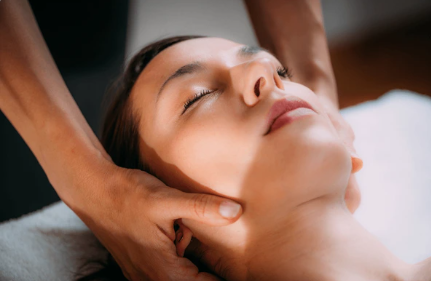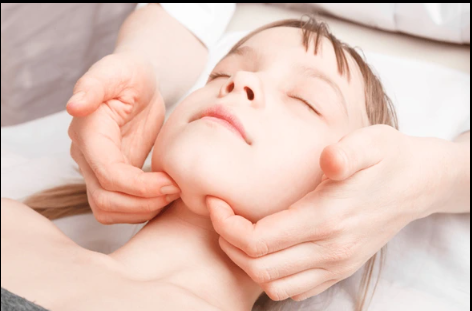Introduction
Cranial Osteopathy is a gentle, non-invasive form of therapy that focuses on the subtle movements of the cranial bones and the rhythmic flow of cerebrospinal fluid. This approach aims to restore balance and harmony within the body’s systems, promoting overall well-being. By addressing imbalances and disruptions in the craniosacral system, Cranial Osteopathy helps improve physical and mental health.
In this article, we will explore:
- The principles of Cranial Osteopathy
- How it can be used to treat various conditions
- Its role in enhancing well-being
We’ll delve into how this therapeutic modality can address specific health issues, from back pain to anxiety disorders. Whether you’re dealing with chronic headaches or seeking holistic support for your child, Cranial Osteopathy offers a pathway to improved health and vitality.
At our Marlborough House Therapy Centre, we have experienced practitioners like Sophie and Sadie, who specialize in Cranial Osteopathy. Our center also provides a range of other therapies such as hypnotherapy, EFT for athletic performance, and relationship coaching that complement the benefits of Cranial Osteopathy.
Before beginning any therapy, it’s important to consult with the right professional. If you’re unsure about which therapy is suitable for your condition, please talk to us.
So whether you’re seeking relief from physical ailments or looking to enhance your overall well-being, Cranial Osteopathy and the complementary therapies offered at Marlborough House Therapy Centre can provide the support you need.
Understanding Cranial Osteopathy
Cranial Osteopathy is a gentle therapy that sets itself apart from other forms of osteopathic treatment by focusing on the craniosacral system. Developed by Dr. William Garner Sutherland in the early 20th century, this approach revolves around the belief that the bones of the skull are not completely fused and can be manipulated to improve health and well-being.
Key Principles of Cranial Osteopathy
- Holistic Perspective: Treating the body as an interconnected system.
- Subtle Techniques: Utilizing light touch to assess and enhance the body’s natural rhythms.
- Patient-Centered Care: Tailoring treatment plans based on individual needs.
The Role of the Craniosacral System
The craniosacral system encompasses the membranes and cerebrospinal fluid surrounding the brain and spinal cord. Cranial Osteopathy works harmoniously with this system, leveraging its natural rhythm to promote healing.
How It Works:
- Assessment: Practitioners use their hands to detect subtle motion within the craniosacral system.
- Manipulation: Gentle adjustments help balance and release tensions.
- Restoration: Facilitates optimal function of the body’s systems, especially those related to the central nervous system.
This alignment with cerebrospinal fluid dynamics is crucial, as it ensures that vital nutrients are effectively distributed throughout the body while waste products are efficiently removed.
Benefits of Gentle Manipulation
The subtle approach used in Cranial Osteopathy offers several advantages:
- Non-invasive: Suitable for patients of all ages, including infants and elderly individuals.
- Minimal Discomfort: The gentle techniques reduce the likelihood of pain or discomfort during and after treatment.
- Comprehensive Relief: Addresses both physical symptoms and underlying causes by restoring balance within the body’s systems.
These benefits make it particularly effective for conditions where more aggressive treatments might not be appropriate. For instance, infants with colic or adults with chronic headaches often show significant improvement with minimal risk.
Evidence Base for Cranial Osteopathy
Scientific research on Cranial Osteopathy continues to evolve, with studies illustrating its potential effectiveness as a therapeutic modality. Key findings include:
- Chronic Pain Management: Research indicates positive outcomes in reducing pain and improving mobility, which could be relevant in cases such as sciatica.
- Headache Relief: Studies have shown benefits for patients suffering from tension headaches and migraines when combined with lifestyle changes, such as those explored in hypnotherapy.
- Pediatric Health: Evidence supports its use in addressing common pediatric issues like feeding difficulties and sleep disturbances.
While some critics argue that more rigorous scientific validation is needed, patient testimonials and clinical observations provide compelling support for its efficacy. Integrating Cranial Osteopathy into a broader care plan often leads to enhanced well-being through improved systemic function and stress reduction.
Understanding these foundational aspects of Cranial Osteopathy sets the stage for exploring how this gentle therapy can address specific physical and mental health conditions, contributing significantly to overall well-being. Additionally, it’s worth noting that this therapy has also shown promise in areas such as [reducing pain, increasing mobility, and improving posture.
 Enhancing Well-being through Cranial Osteopathy: Conditions and Benefits
Enhancing Well-being through Cranial Osteopathy: Conditions and Benefits
Cranial Osteopathy plays a crucial role in improving overall well-being by addressing various physical and mental health issues. It uses gentle, hands-on techniques to:
- Balance the body’s natural rhythms
- Improve function across different systems
- Addressing Physical and Mental Health Issues
Cranial Osteopathy contributes significantly to overall well-being by addressing various physical and mental health issues. By using gentle, hands-on techniques, it aims to balance the body’s natural rhythms and improve function across different systems.
- Treating the Foundation: Alleviating Back Pain and Improving Postural Alignment
Back problems are a common issue many people face. Cranial Osteopathy focuses on resolving underlying imbalances that contribute to back pain. Through subtle manipulations, practitioners can alleviate tension in the spine and surrounding tissues. This approach not only reduces pain but also helps in improving postural alignment. Proper alignment is essential for preventing future injuries and maintaining overall spinal health.
- A Holistic Approach to Headaches
Headaches, especially migraines, can be debilitating. Cranial Osteopathy offers a holistic treatment option for managing these conditions. By gently manipulating the bones in the skull and neck, osteopaths can relieve pressure on cranial nerves and improve blood flow. When combined with lifestyle modifications such as stress management techniques and dietary changes, this approach can significantly reduce the frequency and severity of migraines.
- Benefits for Tinnitus, Anxiety Disorders, and Stress-Related Conditions
Tinnitus, characterized by ringing or buzzing sounds in the ears, can be another challenging condition. Cranial Osteopathy may help by improving circulation and reducing tension around the ear structures. Patients often report a decrease in symptoms after several sessions.
Anxiety disorders and stress-related conditions can also benefit from Cranial Osteopathy. The therapy’s gentle nature makes it particularly effective for calming the nervous system. By focusing on areas like the head, neck, and sacrum, practitioners help release pent-up tension, promoting relaxation and reducing anxiety levels.
- Complementary Therapies for Enhanced Well-being
For those interested in exploring additional therapies that complement Cranial Osteopathy and further enhance their journey toward improved well-being, there are several options available:
- Beauty Treatments: These treatments can provide additional physical and mental rejuvenation, aligning with the goals of Cranial Osteopathy.
- Exploring Hypnosis & Hypnotherapy and Homeopathy. These therapies provide unique insights and benefits for mental and physical health, working hand-in-hand with Cranial Osteopathy.
Incorporating these therapies can further enhance your journey toward improved well-being.
Cranial Osteopathy across the Lifespan: From Infants to Adults
Unique Considerations for Pediatric Patients
Cranial Osteopathy is often recommended for treating common conditions in infants and supporting healthy development in children. This gentle therapy can be particularly effective for:
- Babies experiencing colic, reflux, or feeding difficulties: Subtle manipulations can help alleviate digestive issues, making feeding times more comfortable.
- Children with sleep disturbances or behavioral issues: By promoting relaxation and reducing tension, Cranial Osteopathy can improve sleep patterns and foster emotional well-being.
- Post-birth trauma: The birthing process can be physically demanding for both mother and child. Cranial Osteopathy aims to ease any residual stress or strain in an infant’s body.
Treating the Whole Family
Osteopathic care, including Cranial Osteopathy, provides a continuum of support for individuals of all ages. Families benefit from:
- Comprehensive care: Addressing health concerns that span from infancy to adulthood ensures that each family member receives tailored treatment.
- Preventative strategies: Regular osteopathic sessions can help identify and address potential health issues before they become problematic.
- Holistic well-being: Focusing on the body’s natural rhythms and balance supports overall health, reducing the likelihood of chronic conditions.
For instance, Cranial Osteopathy has shown promising results in alleviating symptoms of IBS (Irritable Bowel Syndrome). This makes it a viable option for individuals across different age groups who are affected by this condition.
Moreover, if you’re part of a new family in Taunton, seeking professional osteopathic care could greatly benefit everyone. Osteopathy for the new family at Marlborough House offers specialized services that cater to the unique needs of both infants and adults.
If you’re unsure about whether Cranial Osteopathy is suitable for your child or yourself, don’t hesitate to ask for help. The experienced practitioners at Marlborough House Therapy Centre can provide guidance and address any concerns you may have.
Safety, Regulation, and Training in Cranial Osteopathy
Ensuring the safe practice of Cranial Osteopathy begins with rigorous training and adherence to ethical guidelines. Practitioners must undergo extensive education and hands-on experience to develop the skills necessary for this gentle yet precise therapy. The importance of proper training cannot be overstated, as it directly impacts the effectiveness and safety of treatments.
Ensuring Safe Practice
- Training and Education: Practitioners are required to complete comprehensive courses that cover anatomy, physiology, and specific cranial techniques. These programs often include supervised clinical practice to ensure competence.
- Experience: Seasoned practitioners bring a wealth of knowledge from years of practice, enhancing their ability to diagnose and treat conditions effectively.
- Ethical Guidelines: Adherence to ethical standards is crucial. Practitioners must maintain professional integrity, ensuring that treatments are performed for the patient’s benefit and within the scope of their expertise.
Regulatory Frameworks
Regulation plays a key role in maintaining high standards within the field of Cranial Osteopathy. At both national and international levels, organizations provide oversight to ensure that practitioners meet stringent criteria.
- General Osteopathic Council (GOsC): In the UK, the GOsC regulates osteopaths, ensuring they are qualified and adhere to professional standards. The council maintains a public register of qualified practitioners, offering a layer of protection for patients.
- European Federation and Forum for Osteopathy (EFFO): On an international level, EFFO works to unify standards across Europe. This organization promotes best practices and supports research initiatives that advance the field.
Addressing Potential Concerns
Despite its benefits, Cranial Osteopathy faces scrutiny due to a perceived lack of clinical evidence. Critics argue that more robust scientific studies are needed to validate its efficacy fully. However, many patients report significant improvements in their conditions following treatment.
Potential Dangers
While generally safe when performed by trained professionals, any therapeutic intervention carries risks. Ensuring that practitioners have adequate training mitigates these risks considerably.
Scientific Evidence vs. Lack of Clinical Evidence
The current body of scientific evidence includes numerous case studies and patient testimonials supporting Cranial Osteopathy’s therapeutic effects. However, large-scale clinical trials remain limited. This gap highlights the need for ongoing research to bridge the divide between anecdotal success and empirical validation.
Integrating these regulatory frameworks and addressing potential concerns ensures that patients receive high-quality care. For those interested in exploring alternative therapies for conditions such as back pain or mental health issues, websites like Marlborough House Therapy Centre offer additional resources on related treatments such as Talking therapies or Reflexology for depression.
By maintaining rigorous standards in training and regulation, Cranial Osteopathy continues to offer a safe and effective option for enhancing well-being across various populations.
Controversies and Future Directions
Addressing Criticisms
Cranial Osteopathy faces its share of skepticism, largely stemming from a perceived lack of scientific evidence. Critics argue that the subtle techniques used in Cranial Osteopathy lack the robust empirical support often demanded by conventional medical paradigms.
Main Arguments by Skeptics:
- Subjectivity in Diagnosis: The palpatory skills required for Cranial Osteopathy are highly subjective, leading to questions about consistency and reliability.
- Placebo Effect: Some detractors attribute the positive outcomes reported by patients to placebo rather than the actual therapeutic effects of Cranial Osteopathy.
Limitations of Traditional Research Paradigms:
Traditional research methods, such as randomized controlled trials (RCTs), may not fully capture the nuances of therapies like Cranial Osteopathy. The individualized nature of treatment and the subtle changes targeted can be challenging to measure using standard biomedical research tools. This points to a need for more innovative research methodologies.
Emerging Areas of Study
Despite criticisms, there are promising avenues for future research that could help validate the effectiveness and broaden the applications of Cranial Osteopathy.
Supporting Recovery from Concussions:
Emerging studies suggest that Cranial Osteopathy could play a role in aiding recovery from concussions. By gently manipulating the craniosacral system, practitioners aim to alleviate symptoms like headaches and cognitive dysfunction that often follow traumatic brain injuries.
Optimizing Oral Function in Infants:
Another exciting area is the potential for Cranial Osteopathy to optimize oral function in infants with sucking difficulties. Ensuring proper craniosacral rhythm can significantly affect an infant’s ability to feed effectively, which is crucial for growth and development.
For those intrigued by these possibilities, exploring comprehensive treatments that include Cranial Osteopathy might offer new pathways toward enhanced well-being. For example, flower essences could be combined with Cranial Osteopathy to address emotional imbalances that may contribute to physical health issues.
Postpartum Recovery and Beyond:
This ongoing exploration highlights the importance of continued research and open-mindedness in evaluating complementary therapies like Cranial Osteopathy. For instance, new mothers can benefit from assessments, which integrate aspects of this therapy to support postpartum recovery. These assessments not only focus on physical rehabilitation but also consider emotional well-being, helping mothers navigate the challenges of early motherhood.
As we move forward, it is crucial to acknowledge the potential of these innovative approaches while maintaining a critical stance. By doing so, we can foster an environment that encourages further research and development in this field.
Conclusion
Cranial Osteopathy offers a unique approach to enhancing well-being by tapping into the body’s innate rhythms and natural healing processes. This gentle therapy has shown potential in addressing various physical and mental health issues, making it a versatile option for individuals across their lifespans.
Encouraging readers to explore Cranial Osteopathy can be pivotal. Consulting with qualified Cranial Osteopaths can provide insights into how this therapy might support your specific health journey.
For those interested in learning more or scheduling a consultation, you might find this resource helpful.
Exploring further, consider how lifestyle changes can complement Cranial Osteopathy. Discovering if your diet impacts your health is another aspect worth looking into. You may find it insightful to read about the influence of diet on your overall health.
Incorporating Cranial Osteopathy into your wellness routine could be a step toward achieving holistic health and balance.


